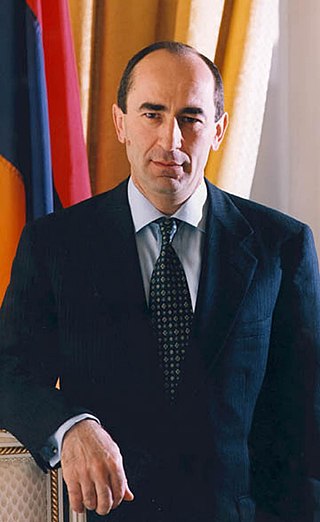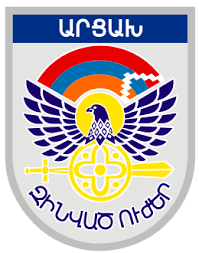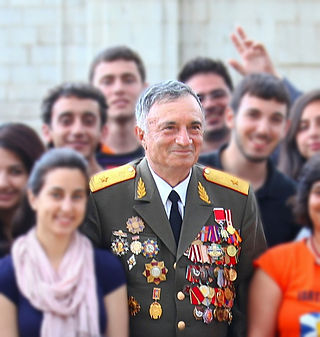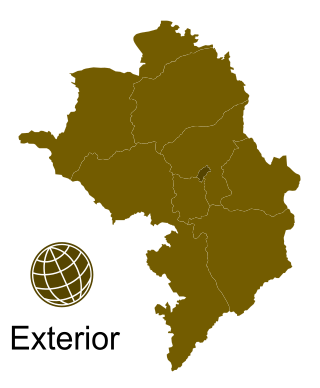
Robert Sedraki Kocharyan is an Armenian politician. He served as the President of the Nagorno-Karabakh Republic from 1994 to 1997 and Prime Minister of Nagorno-Karabakh from 1992 to 1994. He served as the second President of Armenia between 1998 and 2008 and as Prime Minister of Armenia from 1997 to 1998.

Artsakh, officially the Republic of Artsakh or the Republic of Nagorno-Karabakh, was a breakaway state in the South Caucasus whose territory was internationally recognised as part of Azerbaijan. Between 1991 and 2023, Artsakh controlled parts of the former Nagorno-Karabakh Autonomous Oblast of the Azerbaijani Soviet Socialist Republic, including its capital Stepanakert. It had been an enclave within Azerbaijan from the 2020 Nagorno-Karabakh war until the 2023 Azerbaijani offensive, when the Azerbaijani military took control over the remaining territory controlled by Artsakh. Its only overland access route to Armenia after the 2020 war was via the 5 km (3.1 mi) wide Lachin corridor, which was placed under the supervision of Russian peacekeeping forces.

The Artsakh Defence Army was the defence force of the breakaway Republic of Artsakh. Established in 1992, it united previously disorganized defence units which were formed in the early 1990s.

The National Assembly of the Republic of Artsakh is the legislative branch of the government of the Republic of Artsakh.

The Community for Democracy and Rights of Nations, also commonly and colloquially known as the Commonwealth of Unrecognized States, rarely as CIS-2, is an international organization in Eastern Europe and the South Caucasus of three breakaway states in the territory of the former Soviet Union, all of which have limited to no recognition from the international community.

The Republic of Artsakh was a republic with limited recognition in the South Caucasus region. The Republic of Artsakh controlled most of the territory of the former Nagorno-Karabakh Autonomous Oblast. It was recognized only by three other non-UN member states, Abkhazia, South Ossetia and Transnistria. The rest of the international community recognized Artsakh as part of Azerbaijan. In November 2012, a member of Uruguay's foreign relations committee stated that his country could recognize Nagorno-Karabakh's independence. In 2012, Armenia and Tuvalu established diplomatic relations, which led to speculation of possible recognition of Artsakh by Tuvalu. In October 2012, the Australian state of New South Wales recognized Nagorno-Karabakh. In September 2014, the Basque Parliament in Spain adopted a motion supporting Artsakh's right to self-determination and in November 2014, the Parliament of Navarre, also in Spain, issued a statement supporting Artsakh's inclusion in taking part in settlement negotiations.

Arkady Ivani Ter-Tadevosyan, also known by his nom-de-guerre Komandos, was a Soviet and Armenian Major General, a military leader of the Armenian forces during the First Nagorno-Karabakh War and Armenia's former Deputy Minister of Defense. Ter-Tadevosyan is best known as the commander of the operation to capture the town of Shushi on 8–9 May 1992.

Seyran Musheghi Ohanyan is an Armenian general and politician currently serving as a deputy in the National Assembly of Armenia. He served as Defence Minister of Armenia from 14 April 2008 until 3 October 2016. A native of Nagorno-Karabakh, he participated in both the first and second Karabakh wars, and from 2000 to 2007 served as defence minister of the unrecognized Republic of Artsakh.

Bako Sahaki Sahakyan is an Armenian politician who served as the third president of the de facto-independent Republic of Artsakh from 2007 to 2020. He is the longest-serving president of Artsakh.

Arayik Vladimiri Harutyunyan is an Armenian politician who served as the fourth president of the Republic of Artsakh from May 2020 to September 2023. Under his predecessor Bako Sahakyan, he served as the sixth and last Prime Minister from 2007 until the abolishment of that position in 2017 and as the first State Minister of the Republic of Artsakh from 2017 until his resignation in 2018. Harutyunyan led Artsakh through the 2020 Nagorno-Karabakh War with Azerbaijan, during which the republic lost most of the territory under its control. He resigned on 1 September 2023 in the midst of the Azerbaijani blockade of Nagorno-Karabakh.

The following outline is provided as an overview and topical guide of the Republic of Artsakh and Nagorno-Karabakh region:

Before the 2020 Nagorno-Karabakh war, the economy of the Republic of Artsakh was small, but rapidly growing. The economy of Karabakh showed a relatively quick and confident recovery from the 1991-1994 war. In 1999, the GDP figure was $59 million, 80 percent down on the figure in Soviet times. Yet, the GDP of the Republic of Artsakh reached $114 million in 2005, double the figure in 2001, registering economic growth of 14% in 2005, and in 2009 it registered a GDP of $260 million, which increased to $320 million by 2010. Nagorno-Karabakh's GDP (PPP) for 2010 was estimated at $1.6 billion.
This page lists in alphabetical order articles related to the Republic of Artsakh and Nagorno-Karabakh region. For a topically arranged list of articles, please see Outline of the Republic of Artsakh.

The president of the National Assembly of the Republic of Artsakh was the speaker of the House in the Parliament of Artsakh.

The Constitution of the Republic of Artsakh was the basic law of the Republic of Artsakh. It was approved by the people of Artsakh in a referendum that was held on 20 February 2017. It superseded the constitution previously ratified by the people in 2006. Over 76.5% of the electorate participated in the 2017 referendum. Of these, over 90% voted for its adoption with just under 10% voting against its adoption. This constitution proclaimed the Nagorno-Karabakh Republic to be a sovereign, democratic state that was based on social justice and the rule of law. The constitution stated that the names "Republic of Artsakh" and "Republic of Nagorno-Karabakh" were synonymous. The constitution affirmed that all power is vested in its citizens, who exercise it directly through constitutional referendums and indirectly through their elected representatives. Proposed changes to the constitution or to an alteration of the borders of the State had to be ratified by the people in a referendum. Stepanakert was defined as the state's capital. As a result of the Azerbaijani offensive, the constitution was repealed when on 28 September 2023, the president of Artsakh subsequently signed a decree to dissolve all of the republic's institutions by 1 January 2024, under article 93, bringing its existence to an end.

The political status of Nagorno-Karabakh remained unresolved from its declaration of independence on 10 December 1991 to its September 2023 collapse. During Soviet times, it had been an ethnic Armenian autonomous oblast of the Azerbaijan Soviet Socialist Republic. Following the dissolution of the Soviet Union, a conflict arose between local Armenians who sought to have Nagorno-Karabakh join Armenia and local Azerbaijanis who opposed this.

A constitutional referendum was held in the unrecognised Republic of Nagorno-Karabakh on 20 February 2017. At least 25% of registered voters needed to vote in favour in order to validate the result. The referendum passed with about three quarters of voters voting.

General elections were held in the Republic of Artsakh on 31 March 2020, with a second round of the presidential election on 14 April. Voters elected the President and 33 members of the National Assembly. It was the first time the President and National Assembly were elected at the same time.

The State Minister of Artsakh was a political post in the Republic of Artsakh. The position was introduced after constitutional amendments, which were approved in a constitutional referendum in 2017, and after the Prime Minister of Artsakh post was abolished.

Government of the Republic of Artsakh was the executive branch of the government of the Republic of Artsakh. The executive council of government ministers is headed by the President of Artsakh. The 2017 constitutional referendum approved the transformation of the government into a presidential system; the office of the Prime Minister was thereby abolished.






















